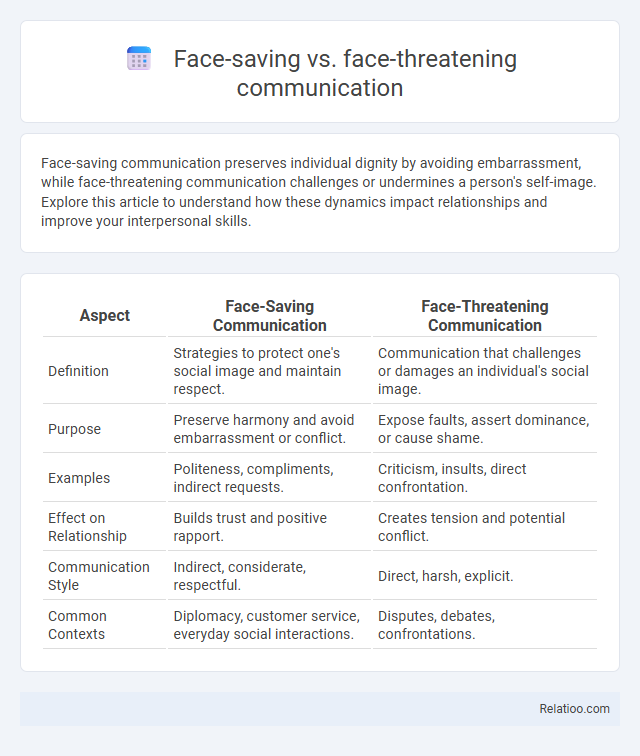Face-saving communication preserves individual dignity by avoiding embarrassment, while face-threatening communication challenges or undermines a person's self-image. Explore this article to understand how these dynamics impact relationships and improve your interpersonal skills.
Table of Comparison
| Aspect | Face-Saving Communication | Face-Threatening Communication |
|---|---|---|
| Definition | Strategies to protect one's social image and maintain respect. | Communication that challenges or damages an individual's social image. |
| Purpose | Preserve harmony and avoid embarrassment or conflict. | Expose faults, assert dominance, or cause shame. |
| Examples | Politeness, compliments, indirect requests. | Criticism, insults, direct confrontation. |
| Effect on Relationship | Builds trust and positive rapport. | Creates tension and potential conflict. |
| Communication Style | Indirect, considerate, respectful. | Direct, harsh, explicit. |
| Common Contexts | Diplomacy, customer service, everyday social interactions. | Disputes, debates, confrontations. |
Understanding Face-Saving and Face-Threatening Communication
Face-saving communication involves strategies aimed at preserving your social image and maintaining respect in interactions, while face-threatening communication poses challenges to one's self-esteem or social identity. Understanding these dynamics helps you navigate conversations by recognizing when to minimize conflict to protect relationships or address issues more directly. Minimization techniques focus on reducing the perceived severity of face-threatening acts to foster positive dialogue and maintain harmony.
The Psychology Behind Face in Social Interactions
Face-saving and face-threatening communication are crucial concepts in social psychology that influence how individuals manage their self-image during interactions, with face-saving involving strategies to protect or enhance one's social dignity, while face-threatening acts challenge or diminish it. Minimization serves as a psychological tactic to reduce the perceived impact or severity of face-threatening situations, helping to maintain social harmony and reduce conflict. Understanding these dynamics allows you to navigate social exchanges more effectively by recognizing when to assert your own face and when to accommodate others'.
Key Differences Between Face-Saving and Face-Threatening Acts
Face-saving communication aims to preserve an individual's dignity and positive self-image during interactions, often by using polite language and avoiding direct confrontation. Face-threatening communication, in contrast, involves messages or actions that can damage a person's social identity or cause embarrassment, such as criticism or rejection. Minimization reduces the perceived severity of face-threatening acts, softening potential harm by downplaying their impact or intent.
Cultural Influences on Face-Saving Behaviors
Cultural influences play a critical role in shaping face-saving behaviors, with collectivist societies emphasizing harmony and indirect communication to avoid face-threatening situations. In contrast, individualistic cultures often prioritize self-expression and may engage more openly in face-threatening communication, viewing directness as honesty. Minimization strategies, such as downplaying conflicts or offending remarks, are frequently employed in high-context cultures to preserve social harmony and maintain interpersonal relationships.
Common Examples of Face-Saving Strategies
Face-saving strategies often involve polite requests, indirect refusals, and compliments to maintain social harmony and protect the interlocutor's self-esteem. In contrast, face-threatening communication includes blunt criticism, direct demands, and confrontational language that may cause embarrassment or loss of face. Minimization reduces the perceived impact of potentially face-threatening acts by downplaying offenses or mistakes, such as saying "just a small error" instead of "a big mistake."
Recognizing Face-Threatening Acts in Conversation
Recognizing face-threatening acts (FTAs) in conversation involves understanding how certain statements or behaviors can challenge or damage Your social image or self-esteem, which are central to face-saving and face-threatening communication theories. Face-saving strategies aim to protect or restore respect and dignity, while face-threatening communication directly or indirectly causes embarrassment, criticism, or loss of status. Minimization techniques reduce the severity of FTAs, allowing smoother interactions by softening the impact of potentially offensive or confrontational remarks.
The Impact of Face-Threatening Communication on Relationships
Face-threatening communication often damages trust and intimacy by challenging an individual's self-esteem and social image, leading to increased conflict and emotional distance in relationships. In contrast, face-saving strategies help maintain respect and harmony by avoiding embarrassment and fostering open, empathetic dialogue. Minimization reduces perceived threats by downplaying negative information, which can prevent escalation but may also hinder genuine resolution if important issues are not fully addressed.
Techniques to Minimize Face Threats in Dialogue
Techniques to minimize face threats in dialogue include using politeness strategies such as indirect requests, hedging, and positive reinforcement to preserve the interlocutor's self-esteem and social image. Employing active listening and acknowledging the speaker's perspective helps reduce potential conflicts by showing empathy and respect for their face needs. Your ability to balance assertiveness with tact ensures smoother communication and prevents escalation of face-threatening acts.
Face-Saving Communication in Workplace Dynamics
Face-saving communication in workplace dynamics involves strategies that protect Your self-image and preserve professional relationships by avoiding embarrassment or conflict. This approach fosters trust, encourages open dialogue, and maintains team cohesion by respecting colleagues' dignity during interactions. Emphasizing positive reinforcement and tactful feedback enhances collaboration and productivity in organizational settings.
Enhancing Communication Skills Through Face Awareness
Face-saving communication emphasizes preserving others' dignity and self-esteem, while face-threatening communication risks causing embarrassment or loss of respect. Minimization involves reducing the perceived severity of a face threat to maintain harmony and avoid conflict. Enhancing communication skills through face awareness fosters empathy, improves conflict resolution, and builds stronger interpersonal relationships by recognizing and managing these dynamics effectively.

Infographic: Face-saving vs Face-threatening communication
 relatioo.com
relatioo.com